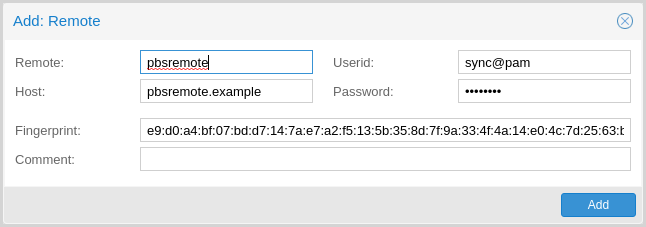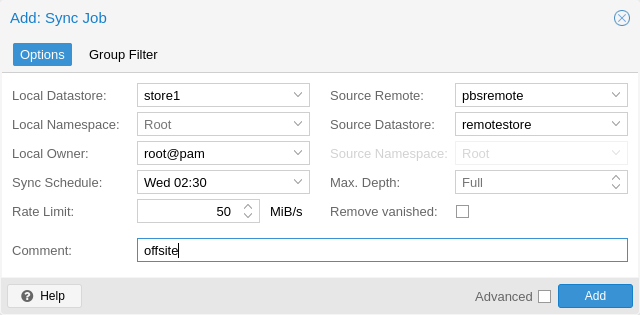Managing Remotes & Sync¶
Remote¶
A remote refers to a separate Proxmox Backup Server installation and a user
on that installation, from which you can sync datastores to a local datastore
with a Sync Job. You can configure remotes in the web interface, under
Configuration -> Remotes. Alternatively, you can use the remote
subcommand. The configuration information for remotes is stored in the file
/etc/proxmox-backup/remote.cfg.

To add a remote, you need its hostname or IP address, a userid and password on
the remote, and its certificate fingerprint. To get the fingerprint, use the
proxmox-backup-manager cert info command on the remote, or navigate to
Dashboard in the remote's web interface and select Show Fingerprint.
# proxmox-backup-manager cert info |grep Fingerprint
Fingerprint (sha256): 64:d3:ff:3a:50:38:53:5a:9b:f7:50:...:ab:fe
Using the information specified above, you can add a remote from the Remotes configuration panel, or by using the command:
# proxmox-backup-manager remote create pbs2 --host pbs2.mydomain.example --userid sync@pam --password 'SECRET' --fingerprint 64:d3:ff:3a:50:38:53:5a:9b:f7:50:...:ab:fe
Use the list, show, update, remove subcommands of
proxmox-backup-manager remote to manage your remotes:
# proxmox-backup-manager remote update pbs2 --host pbs2.example
# proxmox-backup-manager remote list
┌──────┬──────────────┬──────────┬───────────────────────────────────────────┬─────────┐
│ name │ host │ userid │ fingerprint │ comment │
╞══════╪══════════════╪══════════╪═══════════════════════════════════════════╪═════════╡
│ pbs2 │ pbs2.example │ sync@pam │64:d3:ff:3a:50:38:53:5a:9b:f7:50:...:ab:fe │ │
└──────┴──────────────┴──────────┴───────────────────────────────────────────┴─────────┘
# proxmox-backup-manager remote remove pbs2
Sync Jobs¶

Sync jobs are configured to pull the contents of a datastore on a Remote to
a local datastore. You can manage sync jobs in the web interface, from the
Sync Jobs tab of the Datastore panel or from that of the Datastore
itself. Alternatively, you can manage them with the proxmox-backup-manager
sync-job command. The configuration information for sync jobs is stored at
/etc/proxmox-backup/sync.cfg. To create a new sync job, click the add button
in the GUI, or use the create subcommand. After creating a sync job, you can
either start it manually from the GUI or provide it with a schedule (see
Calendar Events) to run regularly.
# proxmox-backup-manager sync-job create pbs2-local --remote pbs2 --remote-store local --store local --schedule 'Wed 02:30'
# proxmox-backup-manager sync-job update pbs2-local --comment 'offsite'
# proxmox-backup-manager sync-job list
┌────────────┬───────┬────────┬──────────────┬───────────┬─────────┐
│ id │ store │ remote │ remote-store │ schedule │ comment │
╞════════════╪═══════╪════════╪══════════════╪═══════════╪═════════╡
│ pbs2-local │ local │ pbs2 │ local │ Wed 02:30 │ offsite │
└────────────┴───────┴────────┴──────────────┴───────────┴─────────┘
# proxmox-backup-manager sync-job remove pbs2-local
To set up sync jobs, the configuring user needs the following permissions:
Remote.Readon the/remote/{remote}/{remote-store}pathAt least
Datastore.Backupon the local target datastore (/datastore/{store})
Note
A sync job can only sync backup groups that the configured remote's
user/API token can read. If a remote is configured with a user/API token that
only has Datastore.Backup privileges, only the limited set of accessible
snapshots owned by that user/API token can be synced.
If the remove-vanished option is set, Datastore.Prune is required on
the local datastore as well. If the owner option is not set (defaulting to
root@pam) or is set to something other than the configuring user,
Datastore.Modify is required as well.
If the group-filter option is set, only backup groups matching at least one
of the specified criteria are synced. The available criteria are:
- Backup type, for example, to only sync groups of the ct (Container) type:
# proxmox-backup-manager sync-job update ID --group-filter type:ct
- Full group identifier, to sync a specific backup group:
# proxmox-backup-manager sync-job update ID --group-filter group:vm/100
- Regular expression, matched against the full group identifier
# proxmox-backup-manager sync-job update ID --group-filter regex:'^vm/1\d{2,3}$'
The same filter is applied to local groups, for handling of the
remove-vanished option.
A group-filter can be inverted by prepending exclude: to it.
- Regular expression example, excluding the match:
# proxmox-backup-manager sync-job update ID --group-filter exclude:regex:'^vm/1\d{2,3}$'
For mixing include and exclude filter, following rules apply:
no filters: all backup groups
include: only those matching the include filters
exclude: all but those matching the exclude filters
both: those matching the include filters, but without those matching the exclude filters
Note
The protected flag of remote backup snapshots will not be synced.
Namespace Support¶
Sync jobs can be configured to not only sync datastores, but also subsets of datastores in the form of namespaces or namespace sub-trees. The following parameters influence how namespaces are treated as part of a sync job's execution:
remote-ns: the remote namespace anchor (default: the root namespace)ns: the local namespace anchor (default: the root namespace)max-depth: whether to recursively iterate over sub-namespaces of the remote namespace anchor (default: None)
If max-depth is set to 0, groups are synced from remote-ns into
ns, without any recursion. If it is set to None (left empty), recursion
depth will depend on the value of remote-ns and the remote side's
availability of namespace support:
remote-nsset to something other than the root namespace: remote must support namespaces, full recursion starting atremote-ns.remote-nsset to root namespace and remote supports namespaces: full recursion starting at root namespace.remote-nsset to root namespace and remote does not support namespaces: backwards-compat mode, only root namespace will be synced intons, no recursion.
Any other value of max-depth will limit recursion to at most max-depth
levels, for example: remote-ns set to location_a/department_b and
max-depth set to 1 will result in location_a/department_b and at most
one more level of sub-namespaces being synced.
The namespace tree starting at remote-ns will be mapped into ns up to a
depth of max-depth.
For example, with the following namespaces at the remote side:
location_a
location_a/department_x
location_a/department_x/team_one
location_a/department_x/team_two
location_a/department_y
location_a/department_y/team_one
location_a/department_y/team_two
location_b
and remote-ns being set to location_a/department_x and ns set to
location_a_dep_x resulting in the following namespace tree on the sync
target:
location_a_dep_x (containing the remote's location_a/department_x)
location_a_dep_x/team_one (containing the remote's location_a/department_x/team_one)
location_a_dep_x/team_two (containing the remote's location_a/department_x/team_two)
with the rest of the remote namespaces and groups not being synced (by this sync job).
If a remote namespace is included in the sync job scope, but does not exist locally, it will be created (provided the sync job owner has sufficient privileges).
If the remove-vanished option is set, namespaces that are included in the
sync job scope but only exist locally are treated as vanished and removed
(provided the sync job owner has sufficient privileges).
Note
All other limitations on sync scope (such as remote user/API token privileges, group filters) also apply for sync jobs involving one or multiple namespaces.
Bandwidth Limit¶
Syncing a datastore to an archive can produce a lot of traffic and impact other
users of the network. In order to avoid network or storage congestion, you can
limit the bandwidth of the sync job by setting the rate-in option either in
the web interface or using the proxmox-backup-manager command-line tool:
# proxmox-backup-manager sync-job update ID --rate-in 20MiB